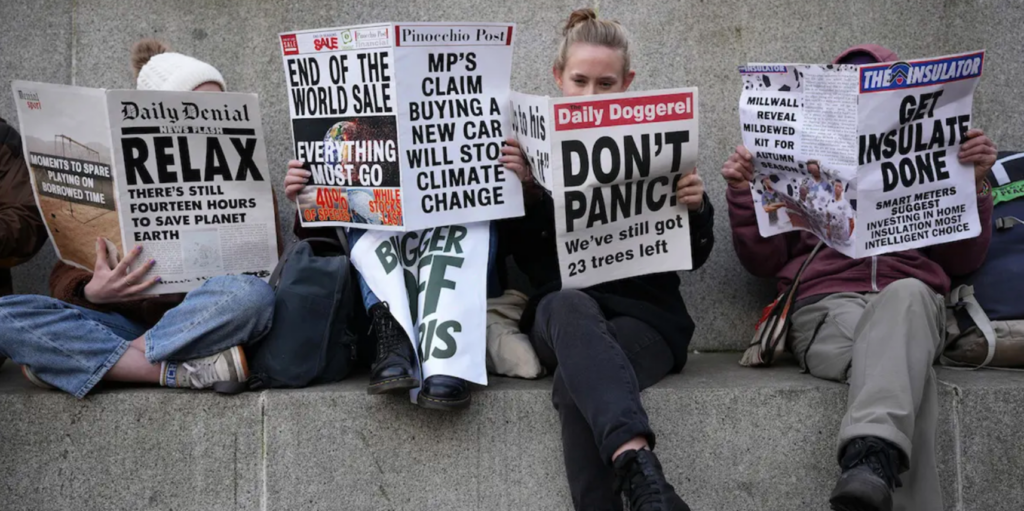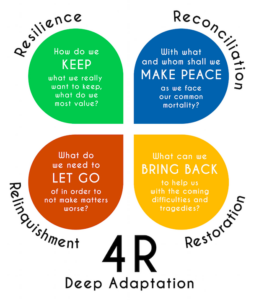In his seminal article, “Deep Adaptation,” Jim Bendell writes, “When I say starvation, destruction, migration, disease and war, I mean in your own life. You will become malnourished. You won’t know whether to stay or go. You will fear being violently killed before starving to death.” Ironically, his doomism extends a unique opportunity to visualise what a peaceful future could look like within the bounds of environmental and societal collapse.
Mainstream peacebuilding frameworks assume that our current systems will endure. The UN’s New Common Agenda for Peace proposes peacebuilding recommendations like improving avenues for development and strengthening international governance and diplomacy. It fails to address what peacebuilding looks like if traditional political systems do not exist in decades to come, if material progress is not possible, or if our financial system does not function.

An apocalypse is not a certainty, but it is absolutely a possibility, asserts Bendell. Slightly different warming scenarios have been projected over the years, but they collectively tend to warn of the likelihood of overshooting many of the points at which damage will have reached irreversible and self-perpetuating levels, unless drastic action is taken immediately. A 2023 study predicted that even if greenhouse gas emissions are reduced considerably, global warming could surpass 2.0 degrees by 2050, and in 2015, MIT projected that if emissions were not reduced, the global average temperature will rise anywhere from 3.1 to 5.2 degrees by 2100.
“A 4 °C warming by 2100 would subject 47% of the land area and almost 74% of the world population to deadly heat, which could pose existential risks to humans and mammals alike,” said a 2017 study. Climate scientists predict that at anywhere between 3 to 5 degrees of global average warming, the Artic ice sheet would collapse, deep water circulation would halt, and Amazon and boreal forests would die. Already, wildfires, droughts, flash floods, and other disasters are happening with alarmingly unnatural frequency. Bendell suggests that if political change remains inadequate and these extreme projections become a reality, then desperation will mount, norms of behaviour will decline, and society will cease to exist in its current state.
These are not inevitable outcomes, but unless there is a dramatic change in policy, scaling of technology, or geoengineering, this vision of doom may be the future we are working with. In his case for pessimism, Dr. Tommy Lynch, from the University of Chichester, wrote that “In abandoning hope that one way of life will continue, we open up a space for alternative hopes.” Climate doomism is not nihilistic. It is an opportunity to visualise what peace could look like in the worst possible scenario, so that we are ready to deeply adapt to a new set of radically different circumstances during and post-apocalypse.
We may have to fundamentally rethink what peace even means in a future that is vastly different than the present. Will peace simply mean survival? Or is it still possible to strive for communal social values like cooperation and respect?
Bendell’s Deep Adaptation Agenda provides the framework through which to start creatively brainstorming how society could adapt. It does not begin with change, but with first identifying which norms should be integrated into society in an apocalyptic future. How do we ensure that norms against sexual violence or murder endure (even if traditional means of enforcement no longer exist)? What measures could be enacted so that gender or racial equality is a priority? Do systems of faith and religion still exist in an organized capacity?
But we will also be forced to give up parts of society currently taken for granted, particularly in the Global North. Already, extreme weather occurrences, like heatwaves or flooding, increase pressure on water provision services and damage electricity generators. Electricity, wifi, and travel are examples of current amenities we may have to relinquish in the future. But this second pillar of the Deep Adaptation Agenda is not only about being forced to grudgingly give up comfort. It is also about the opportunity to critically question what is practical. You could ask, is the nuclear family well suited to a future that is post-civilisation collapse? Gen Dread, a blogging team run by Dr. Britt Wray, would say no. A wide collection of peers, mentors, and loved ones ensures a higher degree of safety, especially if a young person is orphaned. They also suggest that when each individual family unit is “siloed off,” resources are less efficiently shared and dispersed amongst the collective.

The alternatives to that which society relinquishes can come from traditional sources of knowledge [1]. Bendell calls this restoration. He asks what we can learn from ways of life stolen by the industrial revolution, colonialism, and so-called progress? For instance, the nuclear family could be replaced by a model which draws examples of traditional Indigenous kinship. Artificial aspects of our diets could be replaced by methods of harvesting and eating that follow seasonal patterns. If drugs like aspirin run out, natural medicines may be able to be produced on a small scale.
Finally, we are faced with the challenge of how to maintain or reach a degree of inner peace when faced with the psychological impacts of climate and civilisation collapse [2]. Bendell encourages us to search for avenues to the mental resilience and reconciliation necessary to endure in a time of outward chaos and uncertainty.
It is in expecting the worst that we can adequately prepare. Bendell’s “Deep Adaptation”, in all its pessimism about climate change and society, also provides a strange kind of comfort and hope that there are creative ways to adapt and coexist in a different kind of peace.
What do you think?
- Try running through the pillars of The Deep Adaptation Agenda and brainstorm what norms and parts of society need to be made resilient, what parts should be relinquished, what former ways of being could be restored, and how we might reconcile ourselves to civilisation collapse.
- How could the creative deep adaptations that this museum entry (or your own brainstorming) suggest be implemented in policy or society today?
- Do you think it is most useful to hope or to be pragmatic when peacebuilding?
- What do the assumptions of Deep Adaptation tell us about the connection between a healthy environment and inner, community, and geopolitical peace?
If you enjoyed this item in our museum…
You might also enjoy ‘Visualising Peace(ful Cities): The Experimental City,’ ‘UTOPIA / DYSTOPIA,’ and ‘Journey: Visualising Peace Through Gaming.’
Madighan Ryan, October 2023
References and Further Reading
[1] This journal article offers an overview of some traditional sources of knowledge and their applications: https://www.impactjournals.us/index.php/download/archives/–1410954862-5.Applied-Traditional%20Knowledge%20For%20Sustainable-Girindra%20Thakuria.pdf.
[2] To learn more about the psychological consequences of climate change, read this journal article: https://psycnet.apa.org/record/2011-09485-003.
“Deep Adaptation” became the springboard for the Deep Adaptation Forum (which you can find here: https://www.deepadaptation.info/). The website description reads: “Connecting people, in all spheres of life, to foster mutual support and collaboration in the process of anticipating, observing, and experiencing societal disruption and collapse.”